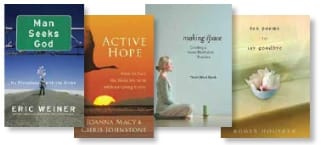Leaning Into Sharp Points:
Practical Guidance and Nurturing Support for Caregivers
By Stan Goldberg
New World Library 2012; 232 pp., $14.95 (paper)
The man’s wife was hooked up to an oxygen regulator. “How do I do this?” he whispered to hospice volunteer Stan Goldberg. “We’ve been married for forty years, but God help me, I don’t know what I should be doing.” This, says Goldberg, is a question that millions of people ask every day when they find themselves thrust into the role of caregiver for someone with a chronic or terminal illness, and for just this reason he offers Leaning Into Sharp Points. Among other important topics, this book addresses how to begin talking about what your loved one has meant to you and how much they will be missed; how to balance your needs against theirs; and how to deal with any abuse or negative behavior they may direct at you due to their illness. Goldberg, whose writing appeared in The Best Buddhist Writing 2010, is also the author of Lessons for the Living: Stories of Forgiveness, Gratitude, and Courage at the End of Life.
A Little Book of Love:
Heart Advice on Bringing Happiness to Ourselves and Our World
By Moh Hardin
Shambhala Publications 2011; 160 pp., $15.95 (cloth)
It is said that all the Buddha’s teachings can be divided into two broad categories: skillful means and wisdom. The wisdom teachings offer insight into the nature of reality, while the skillful means teachings offer instruction for practices. In that vein, Moh Hardin presents both skillful means and wisdom teachings in A Little Book of Love. And—whether he’s addressing listening and speaking with love or building trust or letting go—he always has practical and transformative suggestions. “This is a little book about a big word: love,” Hardin writes in the introduction. “Love is not just a feeling we have toward our spouse, our family, or our friends. It includes these relationships, of course, but love is a way of being present and awake in the world altogether.”
A Couple’s Guide to Sexual Addiction:
A Step-by-Step Plan to Rebuild Trust and Restore Intimacy
By Paldrom Catharine Collins and George N. Collins
Adams Media 2011; 256 pp., $14.95 (paper)
A Couple’s Guide to Sexual Addiction is by husband and wife team Paldrom Catharine Collins and George N. Collins. Paldrom is a former Buddhist nun who helps couples work through sexual addiction through Compulsion Solutions counseling in California. George, a recovering sex addict, is the author of Breaking the Cycle. According to the authors, sex addiction is a compulsive urge to engage in sexual activity, be it having affairs, using prostitutes, or excessively viewing pornography. For the addict, sex is an escape or a balm in a way that is detrimental to the individual, their family, their friends, and/or their work. This book is for couples who have decided to stay together and work through breaches in their relationship caused by sexually compulsive behavior. Part one explores how to come to terms with the shock, hurt, fear, and shame surrounding addiction; part two unpacks the skills required to rebuild the partnership; and part three deals with ways of deepening emotional and sexual intimacy.
The Huston Smith Reader
Edited by Jeffery Paine
University of California Press 2012; 280 pp., $29.95 (cloth)
There was no such thing as comparative religion; if you knew someone of another faith, you ignored them, persecuted them, or tried to convert them. Then, with his 1958 classic, The Religions of Man, Huston Smith showed America another way. He was born in 1919 to missionary parents in China, and he planned to become a missionary himself. Instead, he became what was considered an eccentric college professor. He discovered Hinduism and threw himself into it not just by studying it, but by practicing it for ten years. After that, he spent a decade immersed in Buddhism and another immersed in Islam. Smith’s writing, which spans six decades, is renowned for being highly accessible, and this newly published reader offers a fascinating selection of his work.
Man Seeks God: My Flirtations With the Divine
By Eric Weiner
Twelve Publications 2011; 368 pp., $26.99 (cloth)
Doubled over in pain one evening, Eric Weiner found himself in the emergency room terrified that he had cancer or some unimaginable illness worse than cancer. The nurse, smelling his fear, leaned in to draw blood. “Have you found your God yet?” she asked. As it turns out, the only illness Weiner had was bad indigestion and it quickly passed. The nurse’s question, however, lingered on, eventually evolving into Man Seeks God—an open-minded, if irreverent, exploration of eight different religions. To tackle Buddhism, the wisecracking spiritual seeker traveled to Nepal, where he had a semiprivate audience with Chokyi Nyima Rinpoche; tried to meditate but mostly fixated on the nail clippers he’d forgotten to pack; and circumambulated the stupa of Boudhanath, or in his words, “walked around the Giant Marshmallow.” In the end, Weiner didn’t convert to Buddhism or any other faith; instead, he constructed his own God. The foundation is Judaism, he says, but the support beams are Buddhist.
Making Space: Creating a Home Meditation Practice
By Thich Nhat Hanh
Parallax Press 2011; 96 pp., $9.95 (paper)
Peaceful places create peace in our minds and bodies. “That is the intention of sacred space,” it says in the introduction of this new release. “But we don’t need to wait until we can find a church, temple, mosque, synagogue, or other space designed for sacred contemplation… If we make a space for contemplation and meditation right in our own homes, then peace and joy are always available to us.” In Making Space, Thich Nhat Hanh begins with the how-tos of stopping, breathing, and sitting. Then he delves into the importance of creating a “breathing room” or “breathing corner,” a calm place at home that you can go to when you’re feeling uneasy, sad, or angry, and thereby come back to yourself. Later chapters explore topics such as how to invite the bell, how to make an altar, and how to make your bed a real place of rest and relaxation.
Active Hope: How to Face the Mess We’re in Without Going Crazy
By Joanna Macy and Chris Johnstone
New World Library 2012; 256 pp., $14.95 (paper)
Extreme weather events, a mushrooming population, and dwindling resources—the world’s problems are so big that many of us feel powerless. We do not believe in our ability to change things, so we don’t even try. Yet in this new release, Joanna Macy and Chris Johnstone argue that we don’t need to be optimistic to make positive change. Instead of weighing our chances and proceeding only when we feel hopeful, we can instead be guided by our intentions. This is a three-step practice, which the authors call Active Hope. First, we take in a clear view of reality. Second, we identify what we hope for. And third, we take steps to move ourselves or our situation in that direction. Activist Joanna Macy is a scholar of Buddhism, general systems theory, and deep ecology. Chris Johnstone, author of Find Your Power, teaches on resilience, happiness, and positive change.
Ten Poems to Say Goodbye
By Roger Housden
Harmony Books 2012; 125 pp., $16 (cloth)
Roger Housden’s new release is the perfect poetic accompaniment for this issue’s special section on embracing change. It features ten poems by ten poets, and to accompany each poem Housden offers a thoughtful, lyrical essay. The theme throughout is impermanence, personal loss. Yet the lens is wide and takes in not just grief and sorrow, but also healing and joy. “A goodbye,” says Housden in the introduction, “is an opportunity for kindness, for forgiveness, for intimacy, and ultimately for love and a deepening acceptance of life as it is instead of what it was or what we may have wanted it to be.” Ten Poems to Say Goodbye stands strongly on its own. That said, it is the final volume in a series of six by Housden, the first being Ten Poems to Change Your Life, which was published a decade ago. The poets featured in Ten Poems to Say Goodbye include Pablo Neruda, e.e. cummings, and Buddhist practitioners Leonard Cohen and Jane Hirshfield.

